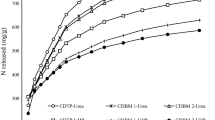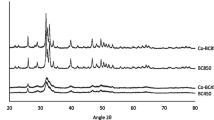Abstract
Formulating biochar-based nitrogen fertilisers from charred livestock manure and urea, the two largest emitters of ammonia (NH3) may help to abate particulate matter emitted from agricultural operations. However, animal manure biochar inadequately retains carbon, thus impairing its primary role of carbon sequestration. Co-pyrolysis of animal manure with phosphorus (P) may improve quality of the biochar, but with the phosphate rock reserves expected to vanish soon, a shift to renewable P sources is desirable. Bone waste is laden with P and can be a viable replacement of the phosphate rock. In the current study, we assessed the efficiency of bone waste as a P source in the co-pyrolysis of cow dung and quantified the NH3 emitting potentials of the biochar-based urea and UHP fertilisers formulated with the co-pyrolysed biochar. Co-pyrolysis of cow dung with bone waste increased yield and carbon retentions of biochar and boosted biochar’s capacity to attenuate NH3 emissions. UHP fertilisers formulated from the co-pyrolysed biochar lessened NH3 evolutions by as high as 85.93% and were more effective in reducing NH3 volatilisations than co-pyrolysed biochar-based urea fertilisers.




Similar content being viewed by others
References
Goebes MD, Strader R, Davidson C (2003) An ammonia emission inventory for fertilizer application in the United States. Atmos Environ 37(18):2539–2550. https://doi.org/10.1016/s1352-2310(03)00129-8
Pozzer A, Tsimpidi AP, Karydis VA, de Meij A, Lelieveld J (2017) Impact of agricultural emission reductions on fine-particulate matter and public health. Atmos Chem Phys 17(20):12813–12826. https://doi.org/10.5194/acp-17-12813-2017
Roumeliotis TS, Van Heyst BJ (2008) Summary of ammonia and particulate matter emission factors for poultry operations. J Appl Poult Res 17(2):305–314. https://doi.org/10.3382/japr.2007-00073
Wang S, Nan J, Shi C, Fu Q, Gao S, Wang D, Cui H, Saiz-Lopez A, Zhou B (2015) Atmospheric ammonia and its impacts on regional air quality over the megacity of Shanghai, China. Sci Rep. https://doi.org/10.1038/srep15842
Tsimpidi AP, Karydis VA, Pandis SN (2007) Response of inorganic fine particulate matter to emission changes of sulfur dioxide and ammonia: the Eastern United States as a case study. J Air Waste Manag Assoc 57(12):1489–1498. https://doi.org/10.3155/1047-3289.57.12.1489
Pinder RW, Gilliland AB, Dennis RL (2008) Environmental impact of atmospheric NH3 emissions under present and future conditions in the eastern United States. Geophys Res Lett. https://doi.org/10.1029/2008gl033732
Wang S, Xing J, Jang C, Zhu Y, Fu JS, Hao J (2011) Impact Assessment of ammonia emissions on inorganic aerosols in East China using response surface modeling technique. Environ Sci Technol 45(21):9293–9300
Megaritis AG, Fountoukis C, Charalampidis PE, Pilinis C, Pandis SN (2013) Response of fine particulate matter concentrations to changes of emissions and temperature in Europe. Atmos Chem Phys 13(6):3423–3443. https://doi.org/10.5194/acp-13-3423-2013
Bessagnet B, Beauchamp M, Guerreiro C, de Leeuw F, Tsyro S, Colette A, Meleux F, Rouıl L, Ruyssenaars P, Sauter F, Velders GJM, Foltescu VL, Aardenne JV (2014) Can further mitigation of ammonia emissions reduce exceedances of particulate matter air quality standards? Environ Sci Policy 44:149–163. https://doi.org/10.1016/j.envsci.2014.07.011
Mandal S, Thangarajan R, Bolan NS, Sarkar B, Khan N, Ok YS, Naidu R (2016) Biochar-induced concomitant decrease in ammonia volatilization and increase in nitrogen use efficiency by wheat. Chemosphere 142:120–127
Sun X, Zhong T, Zhang L, Zhang K, Wu W (2019) Reducing ammonia volatilization from paddy field with rice straw derived biochar. Sci Total Environ 660:512–518. https://doi.org/10.1016/j.scitotenv.2018.12.450
Subedi R, Kammann C, Pelissetti S, Taupe N, Bertora C, Monaco S, Grignani C (2015) Does soil amended with biochar and hydrochar reduce ammonia emissions following the application of pig slurry? Eur J Soil Sci 66(6):1044–1053. https://doi.org/10.1111/ejss.12302
Fan C, Chen H, Li B, Xiong Z (2017) Biochar reduces yield-scaled emissions of reactive nitrogen gases from vegetable soils across China. Biogeosciences 14(11):2851–2863. https://doi.org/10.5194/bg-14-2851-2017
Feng Y, Sun H, Xue L, Liu Y, Gao Q, Lu K, Yang L (2017) Biochar applied at an appropriate rate can avoid increasing NH 3 volatilization dramatically in rice paddy soil. Chemosphere 168:1277–1284. https://doi.org/10.1016/j.chemosphere.2016.11.151
He T, Liu D, Yuan J, Luo J, Lindsey S, Bolan N, Ding W (2018) Effects of application of inhibitors and biochar to fertilizer on gaseous nitrogen emissions from an intensively managed wheat field. Sci Total Environ 628–629:121–130. https://doi.org/10.1016/j.scitotenv.2018.02.048
Chen L, Chen Q, Rao P, Yan L, Shakib A, Shen G (2018) Formulating and optimizing a novel biochar-based fertilizer for simultaneous slow-release of nitrogen and immobilization of cadmium. Sustainability 10(8):2740
Puga AP, de Queiroz MCA, Ligo MAV, Carvalho CS, Pires AMM, de Marcatto JOS, Andrade CA (2019) Nitrogen availability and ammonia volatilization in biochar-based fertilizers. Arch Agron Soil Sci. https://doi.org/10.1080/03650340.2019.1650916
Liu X, Liao J, Song H, Yang Y, Guan C, Zhang Z (2019) A biochar-based route for environmentally friendly controlled release of nitrogen: urea-loaded biochar and bentonite composite. Sci Rep. https://doi.org/10.1038/s41598-019-46065-3
Zhao L, Cao X, Zheng W, Kan Y (2014) Phosphorus-assisted biomass thermal conversion: reducing carbon loss and improving biochar stability. PLoS ONE 9(12):e115373. https://doi.org/10.1371/journal.pone.0115373
Zhao L, Cao X, Zheng W, Scott JW, Sharma BK, Chen X (2016) Co-pyrolysis of biomass with phosphate fertilizers to improve biochar carbon retention, slow nutrient release, and stabilize heavy metals in soil. ACS Sustain Chem Eng 4(3):1630–1636. https://doi.org/10.1021/acssuschemeng.5b01570
Cordell D, Drangert J-O, White S (2009) The story of phosphorus: global food security and food for thought. Glob Environ Change 19(2):292–305. https://doi.org/10.1016/j.gloenvcha.2008.10.009
Dawson CJ, Hilton J (2011) Fertiliser availability in a resource-limited world: production and recycling of nitrogen and phosphorus. Food Policy 36:S14–S22. https://doi.org/10.1016/j.foodpol.2010.11.012
Thangarajan R, Bolan NS, Tian G, Naidu R, Kunhikrishnan A (2013) Role of organic amendment application on greenhouse gas emission from soil. Sci Total Environ 465:72–96. https://doi.org/10.1016/j.scitotenv.2013.01.031
Maynard DG, Kalra YP, Crumbaugh JA (2007) Nitrate and exchangeable ammonium nitrogen (chapter 6) Pages 71–80 in M.R. Carter and E.G. Gregorich (eds). Soil sampling and methods of analysis (2nd edn). CRC Press, Taylor and Francis Group, Boca Raton, FL. 1264 p 26
Mianowski A, Owczarek M, Marecka A (2007) Surface area of activated carbon determined by the iodine adsorption number. Energy Sour Part A Recovery Util Environ Eff 29(9):839–850. https://doi.org/10.1080/00908310500430901
Phuong, D.T.M (2018) Physicochemical Properties and Adsorption Capacity of Biochars Produced from Residues of Two Rice Varieties (Oryza sativa). (Ph.D. thesis) Japanese Koshihikari and Vietnamese IR50404. https://hdl.handle.net/10069/38684
Nunes CA, Guerreiro MC (2011) Estimation of surface area and pore volume of activated carbons by methylene blue and iodine numbers. Química Nova 34(3):472–476. https://doi.org/10.1590/s0100-40422011000300020
Lustosa Filho JF, Penido ES, Castro PP, Silva CA, Melo LCA (2017) Co-pyrolysis of poultry litter and phosphate and magnesium generates alternative slow-release fertilizer suitable for tropical soils. ACS Sustain Chem Eng 5(10):9043–9052. https://doi.org/10.1021/acssuschemeng.7b01935
Jiang T, Feng X, Wang Q, Xiao Z, Wang F, Xie Y (2014) Fire performance of oak wood modified with N-methylol resin and methylolated guanylurea phosphate/boric acid-based fire retardant. Constr Build Mater 72:1–6
Bolan NS, Saggar S, Luo J, Bhandral R, Singh J (2004) Gaseous emissions of nitrogen from grazed pastures: processes, measurements and modelling, environmental implications, and mitigation. Adv Agron 84:37–120
McElroy MB (2002) The atmospheric environment: effects of human activity. Princeton University Press, Princeton
Sarkar B, Naidu R (2014) Nutrient and water use efficiency in soil: the influence of geological mineral amendments. Nutr Use Effic Basics Adv. https://doi.org/10.1007/978-81-322-2169-2_3
Wang B, Lee X, Theng BKG, Zhang L, Cheng H, Cheng J, Lyu W (2019) Biochar addition can reduce NOx gas emissions from a calcareous soil. Environ Pollut Bioavailab 31(1):38–48
Dong D, Wang C, Van Zwieten L, Wang H, Jiang P, Zhou M, Wu W (2019) An effective biochar-based slow-release fertilizer for reducing nitrogen loss in paddy fields. J Soils Sediments. https://doi.org/10.1007/s11368-019-02401-8
Shi W, Ju Y, Bian R, Li L, Joseph S, Mitchell DRG, Munroe P, Taherymoosavi S, Pan G (2019) Biochar bound urea boosts plant growth and reduces nitrogen leaching. Sci Total Environ. https://doi.org/10.1016/j.scitotenv.2019.134424
Taghizadeh-Toosi A, Clough TJ, Sherlock RR, Condron LM (2012) Biochar adsorbed ammonia is bioavailable. Plant Soil 350:57–69
Sarkhot DV, Berhe AA, Ghezzehei TA (2012) Impact of biochar enriched with dairy manure effluent on carbon and nitrogen dynamics. J Environ Qual 41(4):1107. https://doi.org/10.2134/jeq2011.0123
Tian J, Miller V, Chiu PC, Maresca JA, Guo M, Imhoff PT (2016) Nutrient release and ammonium sorption by poultry litter and wood biochars in storm water treatment. Sci Total Environ 553:596–606. https://doi.org/10.1016/j.scitotenv.2016.02.129
Kammann CI, Schmidt H-P, Messerschmidt N, Linsel S, Steffens D, Müller C, Koyrol H-W, Conte P, Joseph S (2015) Plant growth improvement mediated by nitrate capture in co-composted biochar. Sci Rep. https://doi.org/10.1038/srep11080
Haider G, Steffens D, Müller C, Kammann CI (2016) Standard extraction methods may underestimate nitrate stocks captured by field aged biochar. J Environ Qual 45:1196–1204
Haider G, Steffens D, Moser G, Müller C, Kammann CI (2017) Biochar reduced nitrate leaching and improved soil moisture content without yield improvements in a four-year field study. Agr Ecosyst Environ 237:80–94
Dempster DN, Gleeson DB, Solaiman ZM, Jones DL, Murphy DV (2011) Decreased soil microbial biomass and nitrogen mineralisation with Eucalyptus biochar addition to a coarse textured soil. Plant Soil 354(1–2):311–324. https://doi.org/10.1007/s11104-011-1067-5
Castaldi S, Riondino M, Baronti S, Esposito FR, Marzaioli R, Rutigliano FA, Vaccari FP, Miglietta F (2011) Impact of biochar application to a Mediterranean wheat crop on soil microbial activity and greenhouse gas fluxes. Chemosphere 85(9):1464–1471. https://doi.org/10.1016/j.chemosphere.2011.08.031
Bruun E, Ambus P, Egsgaard H, Hauggaard-Nielsen H (2012) Effects of slow and fast pyrolysis biochar on soil C and N turnover dynamics. Soil Biol Biochem 46(4):73–79. https://doi.org/10.1016/j.soilbio.2011.11.019
Ippolito JA, Novak JM, Busscher WJ, Ahmedna M, Rehrah D, Watts DW (2012) Switchgrass Biochar Affects Two Aridisols. J Environ Qual 41(4):1123. https://doi.org/10.2134/jeq2011.0100
Verdi L, Mancini M, Ljubojevic M, Orlandini S, Dalla Marta A (2018) Greenhouse gas and ammonia emissions from soil: the effect of organic matter and fertilisation method. Ital J Agron. https://doi.org/10.4081/ija.2018.1124
Acknowledgements
This research study was conducted with support from a research grant from the Cooperative Research Program for Agricultural Science & Technology Development of Rural Development Administration, Republic of Korea (Project No. PJ014253022019).
Author information
Authors and Affiliations
Contributions
All authors contributed to the study conception and design. LD collected data, conducted the laboratory and statistical analyses and wrote the manuscript while JL helped him with procuring the required materials and in some aspects of data collection and analysis. TKO and JS supervised the experiment and offered technical guidance throughout the entire research period.
Corresponding authors
Additional information
Publisher's Note
Springer Nature remains neutral with regard to jurisdictional claims in published maps and institutional affiliations.
Electronic supplementary material
Below is the link to the electronic supplementary material.
Rights and permissions
About this article
Cite this article
Luyima, D., Lee, JH., Sung, J. et al. Co-pyrolysed animal manure and bone meal-based urea hydrogen peroxide (UHP) fertilisers are an effective technique of combating ammonia emissions. J Mater Cycles Waste Manag 22, 1887–1898 (2020). https://doi.org/10.1007/s10163-020-01074-7
Received:
Accepted:
Published:
Issue Date:
DOI: https://doi.org/10.1007/s10163-020-01074-7




